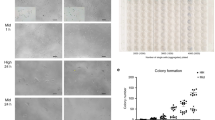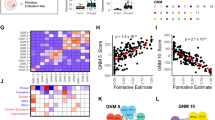Abstract
Many reprogramming methods can generate human induced pluripotent stem cells (hiPSCs) that closely resemble human embryonic stem cells (hESCs). This has led to assessments of how similar hiPSCs are to hESCs, by evaluating differences in gene expression, epigenetic marks and differentiation potential. However, all previous studies were performed using hiPSCs acquired from different laboratories, passage numbers, culturing conditions, genetic backgrounds and reprogramming methods, all of which may contribute to the reported differences. Here, by using high-throughput sequencing under standardized cell culturing conditions and passage number, we compare the epigenetic signatures (H3K4me3, H3K27me3 and HDAC2 ChIP-seq profiles) and transcriptome differences (by RNA-seq) of hiPSCs generated from the same primary fibroblast population by using six different reprogramming methods. We found that the reprogramming method impacts the resulting transcriptome and that all hiPSC lines could terminally differentiate, regardless of the reprogramming method. Moreover, by comparing the differences between the hiPSC and hESC lines, we observed a significant proportion of differentially expressed genes that could be attributed to polycomb repressive complex targets.
This is a preview of subscription content, access via your institution
Access options
Access Nature and 54 other Nature Portfolio journals
Get Nature+, our best-value online-access subscription
$29.99 / 30 days
cancel any time
Subscribe to this journal
Receive 12 digital issues and online access to articles
$99.00 per year
only $8.25 per issue
Buy this article
- Purchase on Springer Link
- Instant access to full article PDF
Prices may be subject to local taxes which are calculated during checkout






Similar content being viewed by others
References
Takahashi, K. & Yamanaka, S. Induction of pluripotent stem cells from mouse embryonic and adult fibroblast cultures by defined factors. Cell 126, 663–676 (2006).
Chin, M. H. et al. Induced pluripotent stem cells and embryonic stem cells are distinguished by gene expression signatures. Cell Stem Cell 5, 111–123 (2009).
Wernig, M. et al. In vitro reprogramming of fibroblasts into a pluripotent ES-cell-like state. Nature 448, 318–324 (2007).
Bock, C. et al. Reference maps of human ES and iPS cell variation enable high-throughput characterization of pluripotent cell lines. Cell 144, 439–452 (2011).
Choi, J. et al. A comparison of genetically matched cell lines reveals the equivalence of human iPSCs and ESCs. Nat. Biotechnol. 33, 1173–1181 (2015).
Ruiz, S. et al. Identification of a specific reprogramming-associated epigenetic signature in human induced pluripotent stem cells. Proc. Natl Acad. Sci. USA 109, 16196–16201 (2012).
Newman, A. M. & Cooper, J. B. Lab-specific gene expression signatures in pluripotent stem cells. Cell Stem Cell 7, 258–262 (2010).
Guenther, M. G. et al. Chromatin structure and gene expression programs of human embryonic and induced pluripotent stem cells. Cell Stem Cell 7, 249–257 (2010).
Wang, Y. et al. A transcriptional roadmap to the induction of pluripotency in somatic cells. Stem Cell Rev. 6, 282–296 (2010).
Kim, K. et al. Donor cell type can influence the epigenome and differentiation potential of human induced pluripotent stem cells. Nat. Biotechnol. 29, 1117–1119 (2011).
Fusaki, N., Ban, H., Nishiyama, A., Saeki, K. & Hasegawa, M. Efficient induction of transgene-free human pluripotent stem cells using a vector based on Sendai virus, an RNA virus that does not integrate into the host genome. Proc. Jpn Acad. Ser. B Phys. Biol. Sci. 85, 348–362 (2009).
Gifford, C. A. et al. Transcriptional and epigenetic dynamics during specification of human embryonic stem cells. Cell 153, 1149–1163 (2013).
Delgado-Olguin, P. et al. Epigenetic repression of cardiac progenitor gene expression by Ezh2 is required for postnatal cardiac homeostasis. Nat. Genet. 44, 343–347 (2012).
Kyttala, A. et al. Genetic variability overrides the impact of parental cell type and determines iPSC differentiation potential. Stem Cell Rep. 6, 200–212 (2016).
Bhutani, K. et al. Whole-genome mutational burden analysis of three pluripotency induction methods. Nat. Commun. 7, 10536 (2016).
Rouhani, F. et al. Genetic background drives transcriptional variation in human induced pluripotent stem cells. PLoS Genet. 10, e1004432 (2014).
Heilig, C. et al. Implications of glucose transporter protein type 1 (GLUT1)-haplodeficiency in embryonic stem cells for their survival in response to hypoxic stress. Am. J. Pathol. 163, 1873–1885 (2003).
Janaszak-Jasiecka, A. et al. miR-429 regulates the transition between hypoxia-inducible factor (HIF)1A and HIF3A expression in human endothelial cells. Sci. Rep. 6, 22775 (2016).
Wang, C. et al. Hypoxia inhibits myogenic differentiation through p53 protein-dependent induction of Bhlhe40 protein. J. Biol. Chem. 290, 29707–29716 (2015).
Bhandari, D. R. et al. The regulatory role of c-MYC on HDAC2 and PcG expression in human multipotent stem cells. J. Cell. Mol. Med. 15, 1603–1614 (2011).
Marshall, G. M. et al. Transcriptional upregulation of histone deacetylase 2 promotes Myc-induced oncogenic effects. Oncogene 29, 5957–5968 (2010).
Zhang, Z. & Wu, W. S. Sodium butyrate promotes generation of human induced pluripotent stem cells through induction of the miR302/367 cluster. Stem Cells Dev. 22, 2268–2277 (2013).
Huangfu, D. et al. Induction of pluripotent stem cells by defined factors is greatly improved by small-molecule compounds. Nat. Biotechnol. 26, 795–797 (2008).
Kim, K. et al. Epigenetic memory in induced pluripotent stem cells. Nature 467, 285–290 (2010).
Okita, K. et al. A more efficient method to generate integration-free human iPS cells. Nat. Methods 8, 409–412 (2011).
Narsinh, K. H. et al. Generation of adult human induced pluripotent stem cells using nonviral minicircle DNA vectors. Nat. Protoc. 6, 78–88 (2011).
Warren, L. et al. Highly efficient reprogramming to pluripotency and directed differentiation of human cells with synthetic modified mRNA. Cell Stem Cell 7, 618–630 (2010).
Anokye-Danso, F. et al. Highly efficient miRNA-mediated reprogramming of mouse and human somatic cells to pluripotency. Cell Stem Cell 8, 376–388 (2011).
Liao, B. et al. MicroRNA cluster 302–367 enhances somatic cell reprogramming by accelerating a mesenchymal-to-epithelial transition. J. Biol. Chem. 286, 17359–17364 (2011).
Sharma, A. et al. The role of SIRT6 protein in aging and reprogramming of human induced pluripotent stem cells. J. Biol. Chem. 288, 18439–18447 (2013).
Warlich, E. et al. Lentiviral vector design and imaging approaches to visualize the early stages of cellular reprogramming. Mol. Ther. 19, 782–789 (2011).
Quinlan, A. R. & Hall, I. M. BEDTools: a flexible suite of utilities for comparing genomic features. Bioinformatics 26, 841–842 (2010).
Krzywinski, M. I. et al. Circos: An information aesthetic for comparative genomics. Genome Res. 19, 1639–1645 (2009).
Zhang, Y. et al. Model-based analysis of ChIP-Seq (MACS). Genome Biol. 9, R137 (2008).
McLean, C. Y. et al. GREAT improves functional interpretation of cis-regulatory regions. Nat. Biotechnol. 28, 495–501 (2010).
Sun, N. et al. Patient-specific induced pluripotent stem cells as a model for familial dilated cardiomyopathy. Sci. Transl. Med. 4, 130ra147 (2012).
Huber, B. C. et al. Costimulation-adhesion blockade is superior to cyclosporine A and prednisone immunosuppressive therapy for preventing rejection of differentiated human embryonic stem cells following transplantation. Stem Cells 31, 2354–2363 (2013).
Emig, D. et al. AltAnalyze and DomainGraph: analyzing and visualizing exon expression data. Nucleic Acids Res. 38, W755–W762 (2010).
Kasprzyk, A. et al. EnsMart: a generic system for fast and flexible access to biological data. Genome Res. 14, 160–169 (2004).
Trapnell, C. et al. Differential gene and transcript expression analysis of RNA-seq experiments with TopHat and Cufflinks. Nat. Protoc. 7, 562–578 (2012).
Chen, J., Bardes, E. E., Aronow, B. J. & Jegga, A. G. ToppGene Suite for gene list enrichment analysis and candidate gene prioritization. Nucleic Acids Res. 37, W305–W311 (2009).
Subramanian, A. et al. Gene set enrichment analysis: a knowledge-based approach for interpreting genome-wide expression profiles. Proc. Natl Acad. Sci. USA 102, 15545–15550 (2005).
Acknowledgements
This study was funded by the Canadian Institute of Health Research 201210MFE-289547 (J.M.C.), National Institutes of Health 1K99HL128906 (J.M.C.), PCBC_JS_2014/4_01 (J.M.C.), National Research Foundation of Korea 2012R1A6A3A03039821 (J.L.), the Burroughs Wellcome Foundation, National Institutes of Health R01 HL123968, HL128170, R01 HL126527 (J.C.W.), and P01 GM099130 (M.P.S.). The authors would like to thank the Stanford Stem Cell Institute Genome Center for their sequencing knowledge, V. Sebastiano for hESC culturing, and B. Huber for his help with the teratoma assay. We would also like to thank J. Brito and B. Wu for their help in editing the manuscript.
Author information
Authors and Affiliations
Contributions
J.D.G., N.S., M.P.S. and J.C.W. supervised and planned the project. J.M.C. wrote the manuscript, performed data analysis, generated and cultured hiPSC lines, and performed RNA-seq. N.S. and M.V. performed integration analysis. H.I. helped analyse RNA-seq. J.L. performed ChIP-seq experiments. M.A. and M.G. performed FACS analysis on differentiated cardiomyocytes. G.W. and K.S. helped to culture hiPSC and hESC lines. S.D. generated minicircle hiPSC lines.
Corresponding author
Ethics declarations
Competing interests
The authors declare no competing financial interests.
Additional information
Publisher’s note: Springer Nature remains neutral with regard to jurisdictional claims in published maps and institutional affiliations.
Electronic supplementary material
Supplementary Information
Supplementary figures
Supplementary Dataset 1
Reads per kilobase of transcript per million mapped reads of each Ensembl ID, calculated via AltAnalyze.
Supplementary Dataset 2
Gene-expression differences, calculated via a Bayes moderated t-test p-value (unpaired), assuming unequal variance, and p < 0.05 with two-fold difference.
Supplementary Dataset 3
Splicing events between hiPSCs and hESCs.
Supplementary Dataset 4
Differential peaks unique to the hESCs and peaks unique to hiPSCs, corresponding to HDAC2 localization.
Supplementary Dataset 5
Transcriptional-start-site peak-density differences within the H3K4me3 ChIP-seq set between hESCs and hiPSCs.
Supplementary Dataset 6
Transcriptional-start-site peak-density differences in the H3K27me3 ChIP-seq profile between hESCs and hiPSCs.
Rights and permissions
About this article
Cite this article
Churko, J.M., Lee, J., Ameen, M. et al. Transcriptomic and epigenomic differences in human induced pluripotent stem cells generated from six reprogramming methods. Nat Biomed Eng 1, 826–837 (2017). https://doi.org/10.1038/s41551-017-0141-6
Received:
Accepted:
Published:
Issue Date:
DOI: https://doi.org/10.1038/s41551-017-0141-6
This article is cited by
-
Profiling the role of m6A effectors in the regulation of pluripotent reprogramming
Human Genomics (2024)
-
Engineering considerations of iPSC-based personalized medicine
Biomaterials Research (2023)
-
Building gut from scratch — progress and update of intestinal tissue engineering
Nature Reviews Gastroenterology & Hepatology (2022)
-
A non-invasive method to generate induced pluripotent stem cells from primate urine
Scientific Reports (2021)
-
Modeling Precision Cardio-Oncology: Using Human-Induced Pluripotent Stem Cells for Risk Stratification and Prevention
Current Oncology Reports (2021)



